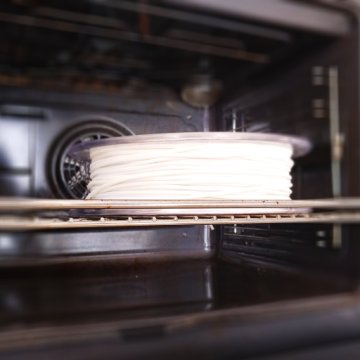Let's dry that filament

Picture this: You're getting ready to start your latest 3D printing project, but when you load up your filament, you notice that it's not that dry as it should be. Oh no! What do you do?
If you're new to 3D printing, you may be wondering why it's important to dry filaments. Filaments are made of chains of molecules, and moisture can lead to water molecules disrupting the chain and ruining the filaments. This can cause difficulties during printing and result in rough, grainy or coarse final products.
To ensure a successful 3D printing process, it's essential to prepare the filament and keep it dry. Heating the filament at the appropriate temperature eliminates moisture that could have been absorbed during storage. While using newly opened filaments may not require drying, it's essential to be cautious when storing them as even seemingly dry places can have moisture.
Moisture can adversely affect the mechanical structure of the filament and lead to layer separation, foaming, and bloating of the final object. By drying filaments, you can avoid these issues and ensure high-quality prints
While there are commercial filament dryers available, you don't necessarily need to spend a lot of money on specialized equipment. Here are some different options for drying your filament at home:
1. Oven Drying:
Place your filament spool in an oven at 30-50°C for 4-6 hours. This will effectively dry out any moisture that may have been absorbed. Make sure to monitor the temperature and don't exceed the recommended temperature or leave the filament in for too long, as this can damage the filament.
2. Microwave Drying
Place the container with the filament in the microwave and set it to a low power setting for 2-3 minutes. Check the filament every 30 seconds to ensure it's not overheating. Some filaments may not dry evenly in a microwave, leading to inconsistent printing results.
3. Dehydrator
Using a food dehydrator is an effective way to dry your filament. Set your dehydrator to the lowest setting and place your spool inside. The low heat and continuous airflow will remove any moisture that may have been absorbed.
4. Silica Gel or clay desiccant
Silica gel or clay desiccant can absorb moisture. You can place silica gel packs inside a sealed container with your filament to remove any moisture that may have been absorbed. Just make sure to use enough silica gel to effectively absorb the moisture.
5. DIY Filament Dryer
You can make your own filament dryer using a plastic storage container, a small desk fan, and some silica gel. Cut a hole in the lid of the container and attach the fan to blow air into the container. Place the silica gel in the container and put your filament spool inside. The fan will blow air over the silica gel and filament, removing any moisture that may have been absorbed.
These are just a few different options for drying your filament at home. Whichever method you choose, make sure to store your filament properly, as it is crucial to maintaining its quality and ensuring successful 3D printing. By taking care of your filament, you'll ensure that your 3D prints are of the highest quality and consistency.
Here are some tips on how to store your filament:
- Keep your filament in a dry and cool place. Moisture and heat can damage your filament and cause printing issues. Airtight containers or vacuum-sealed bags are great for keeping your filament dry.
- Store your filament away from sunlight. UV rays can degrade the quality of the filament and cause discoloration.
- Avoid storing your filament near electronics or appliances that generate heat. Heat can cause the filament to soften or warp.
- When storing multiple filaments, label them with the type of material and the date of purchase. This helps you keep track of which filament to use first and ensures that you're using fresh filament.
At our online store, we offer filaments that come in sustainable cardboard spools, packaged in vacuum-sealed bags with natural clay desiccant, and fitted in a cardboard box. This ensures that our filaments are stored properly and remain in excellent condition until they reach our customers.
In conclusion, storing your filament properly is important for maintaining its quality and ensuring successful 3D printing. By keeping your filament dry, cool, and away from sunlight and heat, you can prolong its lifespan and avoid printing issues.